The Price of Sex, produced by Mimi Chakarova, is a documentary that describes human trafficking in the sex trade and forced prostitution. Chakarova is featured on this podcast discussing the film http://ff.hrw.org/content/price-sex-0. Chakarova describes the life of poverty and destitution that repress many Eastern Europeans. Tempted by the promise of prosperity, many women believe that immigration to the west is the route to a better life. These women often come from small villages where patriarchal values leave daughters with weak family connections. Sex traffickers target these women and lure them with the promise of jobs and security. Once women are taken against their will by the traffickers, they are sold to pimps. These pimps govern complex networks of sex clubs, often located in basements of urban buildings. The process of becoming a sex worker starts with an initial “breaking period.” Women are drugged, starved, and repeatedly raped to establish absolute control over the women and their bodies. The brothels are strategically designed with one entrance and exit and are highly secured.
In this clip from The Price of Sex, Mimi Chakarova conducts interviews to access what makes women vulnerable to becoming sex workers. (http://www.youtube.com/watch?v=ClOpws3XgwY).
Since there is a high degree of secrecy involving this illegal business, the clientele is based off of word-of- mouth referrals and shared relationships. Chakarova remarks that this business is an “invisible industry,” although the women walk the streets and can often be seen from windows of urban buildings. The business of sex trafficking can operate “invisibly” because of the degree of corruption and impunity that supports the industry. Police have been cited as willing participants in the industry. Chakarova tells the story of an escaped former sex worker in Istanbul, who upon freeing herself from her captures, found a police station where she recognized officers as clients from the brothel. The police officers brought the woman back to the brothel.
Chakarova and other researchers maintain that part of the problem of sex trafficking lies with the way in which women are viewed in society. In order to draw attention to and eradicate the human sex trafficking industry, the stigma surrounding rape must be addressed. Victims of sex trafficking often feel ashamed of their past. Chakarova advocates an action plan that starts with changing the way society values women, improvement of education, and enforced penalty, arrest, public trial, and incarceration of those involved. Few women can imagine a worse nightmare that capture, rape, and imprisonment, however, this systematic dehumanizing of women for profit is a disturbing and tragic reality for an unknown number of anonymous women across the globe.







